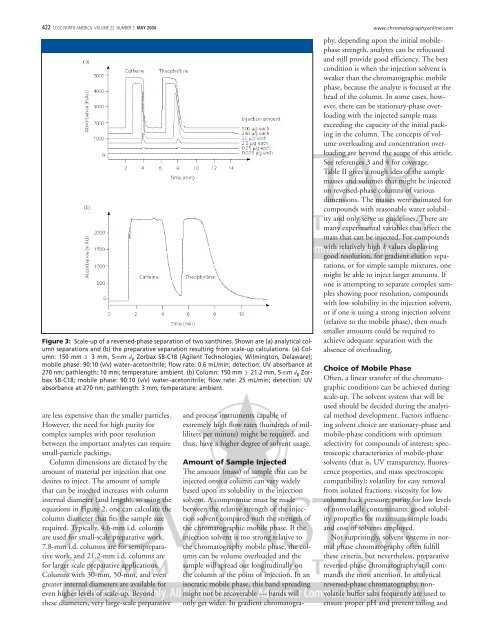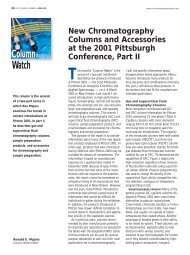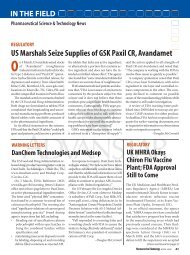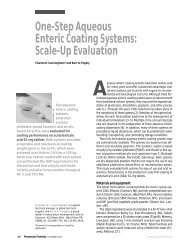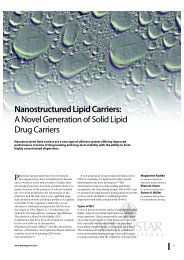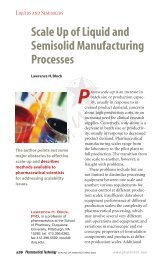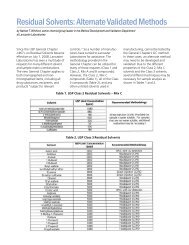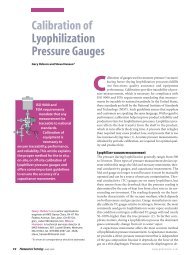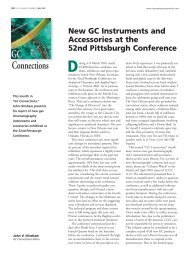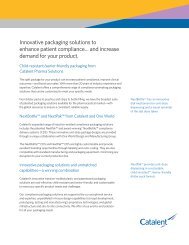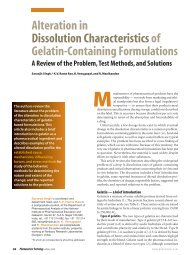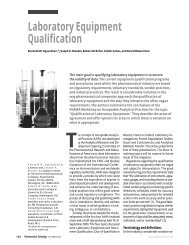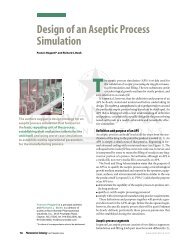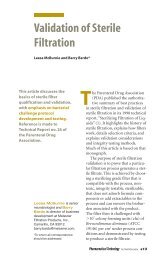The Role of the Column in Preparative HPLC - Chromatography ...
The Role of the Column in Preparative HPLC - Chromatography ...
The Role of the Column in Preparative HPLC - Chromatography ...
You also want an ePaper? Increase the reach of your titles
YUMPU automatically turns print PDFs into web optimized ePapers that Google loves.
422 LCGC NORTH AMERICA VOLUME 22 NUMBER 5 MAY 2004 www.chromatographyonl<strong>in</strong>e.com<br />
Figure 3: Scale-up <strong>of</strong> a reversed-phase separation <strong>of</strong> two xanth<strong>in</strong>es. Shown are (a) analytical column<br />
separations and (b) <strong>the</strong> preparative separation result<strong>in</strong>g from scale-up calculations. (a) <strong>Column</strong>:<br />
150 mm 3 3 mm, 5-mm d p Zorbax SB-C18 (Agilent Technologies, Wilm<strong>in</strong>gton, Delaware);<br />
mobile phase: 90:10 (v/v) water–acetonitrile; flow rate: 0.6 mL/m<strong>in</strong>; detection: UV absorbance at<br />
270 nm; pathlength: 10 mm; temperature: ambient. (b) <strong>Column</strong>: 150 mm 3 21.2 mm, 5-mm d p Zorbax<br />
SB-C18; mobile phase: 90:10 (v/v) water–acetonitrile; flow rate: 25 mL/m<strong>in</strong>; detection: UV<br />
absorbance at 270 nm; pathlength: 3 mm; temperature: ambient.<br />
are less expensive than <strong>the</strong> smaller particles.<br />
However, <strong>the</strong> need for high purity for<br />
complex samples with poor resolution<br />
between <strong>the</strong> important analytes can require<br />
small-particle pack<strong>in</strong>gs.<br />
<strong>Column</strong> dimensions are dictated by <strong>the</strong><br />
amount <strong>of</strong> material per <strong>in</strong>jection that one<br />
desires to <strong>in</strong>ject. <strong>The</strong> amount <strong>of</strong> sample<br />
that can be <strong>in</strong>jected <strong>in</strong>creases with column<br />
<strong>in</strong>ternal diameter (and length), so us<strong>in</strong>g <strong>the</strong><br />
equations <strong>in</strong> Figure 2, one can calculate <strong>the</strong><br />
column diameter that fits <strong>the</strong> sample size<br />
required. Typically, 4.6-mm i.d. columns<br />
are used for small-scale preparative work,<br />
7.8-mm i.d. columns are for semipreparative<br />
work, and 21.2-mm i.d. columns are<br />
for larger scale preparative applications.<br />
<strong>Column</strong>s with 30-mm, 50-mm, and even<br />
greater <strong>in</strong>ternal diameters are available for<br />
even higher levels <strong>of</strong> scale-up. Beyond<br />
<strong>the</strong>se diameters, very large-scale preparative<br />
and process <strong>in</strong>struments capable <strong>of</strong><br />
extremely high flow rates (hundreds <strong>of</strong> milliliters<br />
per m<strong>in</strong>ute) might be required, and<br />
thus, have a higher degree <strong>of</strong> solvent usage.<br />
Amount <strong>of</strong> Sample Injected<br />
<strong>The</strong> amount (mass) <strong>of</strong> sample that can be<br />
<strong>in</strong>jected onto a column can vary widely<br />
based upon its solubility <strong>in</strong> <strong>the</strong> <strong>in</strong>jection<br />
solvent. A compromise must be made<br />
between <strong>the</strong> relative strength <strong>of</strong> <strong>the</strong> <strong>in</strong>jection<br />
solvent compared with <strong>the</strong> strength <strong>of</strong><br />
<strong>the</strong> chromatographic mobile phase. If <strong>the</strong><br />
<strong>in</strong>jection solvent is too strong relative to<br />
<strong>the</strong> chromatography mobile phase, <strong>the</strong> column<br />
can be volume overloaded and <strong>the</strong><br />
sample will spread out longitud<strong>in</strong>ally on<br />
<strong>the</strong> column at <strong>the</strong> po<strong>in</strong>t <strong>of</strong> <strong>in</strong>jection. In an<br />
isocratic mobile phase, this band spread<strong>in</strong>g<br />
might not be recoverable — bands will<br />
only get wider. In gradient chromatography,<br />
depend<strong>in</strong>g upon <strong>the</strong> <strong>in</strong>itial mobilephase<br />
strength, analytes can be refocused<br />
and still provide good efficiency. <strong>The</strong> best<br />
condition is when <strong>the</strong> <strong>in</strong>jection solvent is<br />
weaker than <strong>the</strong> chromatographic mobile<br />
phase, because <strong>the</strong> analyte is focused at <strong>the</strong><br />
head <strong>of</strong> <strong>the</strong> column. In some cases, however,<br />
<strong>the</strong>re can be stationary-phase overload<strong>in</strong>g<br />
with <strong>the</strong> <strong>in</strong>jected sample mass<br />
exceed<strong>in</strong>g <strong>the</strong> capacity <strong>of</strong> <strong>the</strong> <strong>in</strong>itial pack<strong>in</strong>g<br />
<strong>in</strong> <strong>the</strong> column. <strong>The</strong> concepts <strong>of</strong> volume<br />
overload<strong>in</strong>g and concentration overload<strong>in</strong>g<br />
are beyond <strong>the</strong> scope <strong>of</strong> this article.<br />
See references 3 and 4 for coverage.<br />
Table II gives a rough idea <strong>of</strong> <strong>the</strong> sample<br />
masses and volumes that might be <strong>in</strong>jected<br />
on reversed-phase columns <strong>of</strong> various<br />
dimensions. <strong>The</strong> masses were estimated for<br />
compounds with reasonable water solubility<br />
and only serve as guidel<strong>in</strong>es. <strong>The</strong>re are<br />
many experimental variables that affect <strong>the</strong><br />
mass that can be <strong>in</strong>jected. For compounds<br />
with relatively high k values display<strong>in</strong>g<br />
good resolution, for gradient elution separations,<br />
or for simple sample mixtures, one<br />
might be able to <strong>in</strong>ject larger amounts. If<br />
one is attempt<strong>in</strong>g to separate complex samples<br />
show<strong>in</strong>g poor resolution, compounds<br />
with low solubility <strong>in</strong> <strong>the</strong> <strong>in</strong>jection solvent,<br />
or if one is us<strong>in</strong>g a strong <strong>in</strong>jection solvent<br />
(relative to <strong>the</strong> mobile phase), <strong>the</strong>n much<br />
smaller amounts could be required to<br />
achieve adequate separation with <strong>the</strong><br />
absence <strong>of</strong> overload<strong>in</strong>g.<br />
Choice <strong>of</strong> Mobile Phase<br />
Often, a l<strong>in</strong>ear transfer <strong>of</strong> <strong>the</strong> chromatographic<br />
conditions can be achieved dur<strong>in</strong>g<br />
scale-up. <strong>The</strong> solvent system that will be<br />
used should be decided dur<strong>in</strong>g <strong>the</strong> analytical<br />
method development. Factors <strong>in</strong>fluenc<strong>in</strong>g<br />
solvent choice are stationary-phase and<br />
mobile-phase conditions with optimum<br />
selectivity for compounds <strong>of</strong> <strong>in</strong>terest; spectroscopic<br />
characteristics <strong>of</strong> mobile-phase<br />
solvents (that is, UV transparency, fluorescence<br />
properties, and mass spectroscopic<br />
compatibility); volatility for easy removal<br />
from isolated fractions; viscosity for low<br />
column back pressure; purity for low levels<br />
<strong>of</strong> nonvolatile contam<strong>in</strong>ants; good solubility<br />
properties for maximum sample loads;<br />
and cost <strong>of</strong> solvents employed.<br />
Not surpris<strong>in</strong>gly, solvent systems <strong>in</strong> normal<br />
phase chromatography <strong>of</strong>ten fulfill<br />
<strong>the</strong>se criteria, but never<strong>the</strong>less, preparative<br />
reversed-phase chromatography still commands<br />
<strong>the</strong> most attention. In analytical<br />
reversed-phase chromatography, nonvolatile<br />
buffer salts frequently are used to<br />
ensure proper pH and prevent tail<strong>in</strong>g and


